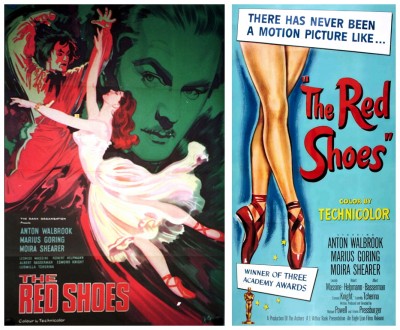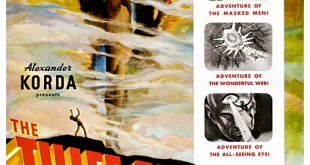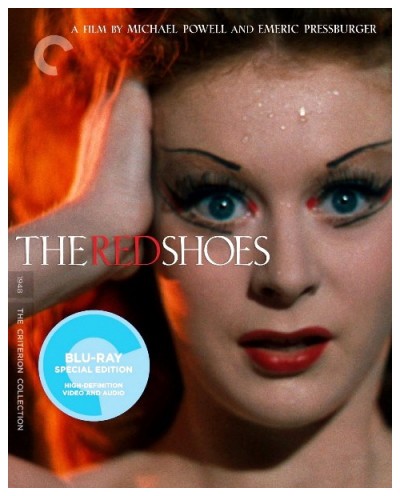 SYNOPSIS:
SYNOPSIS:
“The successful impresario Boris Lermontov gives an opportunity in the Lermontov Opera to the talented young composer and conductor Julian Craster and to the gorgeous red-haired ballerina Victoria ‘Vicky’ Page, whose greatest passion is to dance. Soon Vicky becomes the lead dancer of his company and a sensation in Europe. Craster composes the ballet The Red Shoes based on the fairy-tale of Hans Christian Andersen and Vicky falls in love with him. The jealous Lermontov sends Craster away and Vicky decides to leave the company and marry Craster. However, when Lermontov meets Vicky one year later, he offers the position of lead ballerina in his ballet back to her; the youth feels divided between her passion for dancing and her love for Craster, leading her to a tragic decision.” (courtesy IMDB)
REVIEW:
Fantasy is a term that is often associated with childhood, and it may strike some readers as paradoxical that so many of the fantasies discussed on Horror News were made for adults only. Of course, even children’s fantasies traditionally have a dark side, and many libraries have attempted to ban the fairy-tales of the Brothers Grimm and others as ‘unsuitable for children’ even though they were specifically written for them. However, even during the science fiction horror boom of the fifties, the major studios in the United Kingdom and the United States refused to abandon family-friendly fantasies, and it’s definitely worth looking at some of the key moments in this line of development.
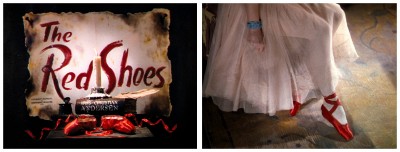 No matter how bright and colourful these fantastic extravaganzas were, the dark side of life still showed through. Perhaps fantasy can only be nurtured upon the polarities of darkness and light – light means nothing without the piquant contrast of its opposite. This was especially true of the fantasies of the British filmmakers Michael Powell and Emeric Pressburger, who worked on nineteen films together. They were a flamboyant pair, and many of their films were rather bizarre and stylised for the period they were made in. Their two outright fantasies were The Tales Of Hoffman (1951), a filmed version of the opera by Jacques Offenbach, and The Red Shoes (1948), a ballet based on the story by Hans Christian Andersen.
No matter how bright and colourful these fantastic extravaganzas were, the dark side of life still showed through. Perhaps fantasy can only be nurtured upon the polarities of darkness and light – light means nothing without the piquant contrast of its opposite. This was especially true of the fantasies of the British filmmakers Michael Powell and Emeric Pressburger, who worked on nineteen films together. They were a flamboyant pair, and many of their films were rather bizarre and stylised for the period they were made in. Their two outright fantasies were The Tales Of Hoffman (1951), a filmed version of the opera by Jacques Offenbach, and The Red Shoes (1948), a ballet based on the story by Hans Christian Andersen.
 Boris Lermontov (Anton Walbrook) is a seemingly heartless ballet impresario who becomes interested in a gifted young dancer named Vicky Page (Moira Shearer in her film debut). Because she agrees with him that dance is more important than life itself, he offers her a position with the National Ballet Theatre. He asks his new extremely talented orchestra coach Julian Craster (Marius Goring) to compose the score for a ballet based on Hans Christian Andersen‘s fairy-tale The Red Shoes for Vicky to dance, about a girl who has an obsessive need to dance in a pair of red shoes. Life and love pass her by and, unable to stop dancing, she dies. Of course, the ballet is meant to parallel Vicky’s story. The ballet is a success but, much to Lermontov’s chagrin, Vicky and Craster fall in love. Lermontov becomes critical of their work and they quit.
Boris Lermontov (Anton Walbrook) is a seemingly heartless ballet impresario who becomes interested in a gifted young dancer named Vicky Page (Moira Shearer in her film debut). Because she agrees with him that dance is more important than life itself, he offers her a position with the National Ballet Theatre. He asks his new extremely talented orchestra coach Julian Craster (Marius Goring) to compose the score for a ballet based on Hans Christian Andersen‘s fairy-tale The Red Shoes for Vicky to dance, about a girl who has an obsessive need to dance in a pair of red shoes. Life and love pass her by and, unable to stop dancing, she dies. Of course, the ballet is meant to parallel Vicky’s story. The ballet is a success but, much to Lermontov’s chagrin, Vicky and Craster fall in love. Lermontov becomes critical of their work and they quit.
 Craster tells Vicky that she’ll never dance The Red Shoes again, but time passes, and Lermontov tries to lure Vicky back by offering her a chance to perform The Red Shoes once more. She must choose between Craster and dancing, and the result is terribly tragic. This classic by Powell and Pressburger is regarded by many to be the best ballet film ever made – although the more recent Black Swan (2010) has become a popular contender for that title. The Red Shoes has inspired generations of young women to become dancers. So glorious are the visuals – movement, colour, sets, costumes – all surrounded by beautiful music, and so strong is the career-versus-marriage conflict which Vicky tries to resolve, that many young women viewers have developed an emotional attachment to the film not equaled since The Wizard Of Oz (1939), another film seen from the point of view of a young woman that also successfully blends fantasy and reality.
Craster tells Vicky that she’ll never dance The Red Shoes again, but time passes, and Lermontov tries to lure Vicky back by offering her a chance to perform The Red Shoes once more. She must choose between Craster and dancing, and the result is terribly tragic. This classic by Powell and Pressburger is regarded by many to be the best ballet film ever made – although the more recent Black Swan (2010) has become a popular contender for that title. The Red Shoes has inspired generations of young women to become dancers. So glorious are the visuals – movement, colour, sets, costumes – all surrounded by beautiful music, and so strong is the career-versus-marriage conflict which Vicky tries to resolve, that many young women viewers have developed an emotional attachment to the film not equaled since The Wizard Of Oz (1939), another film seen from the point of view of a young woman that also successfully blends fantasy and reality.
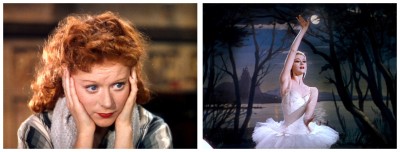 The film is simultaneously romantic and expressionistic, daydream and nightmare, psychological drama and fairy-tale, backstage musical and highbrow art. The film’s highlight is the fourteen-minute ballet of The Red Shoes choreographed by Australian Ballet Company director Sir Robert Helpmann, who also dances in The Red Shoes – Helpmann appeared in a couple of dozen films, including the original version of Patrick (1978), and in Chitty Chitty Bang Bang (1968) as the sinister Child Catcher, voted by Empire Magazine as one of their Hundred Most Frightening Film Characters Ever. Moira Shearer will no doubt stun you with her dancing and she is breathtakingly beautiful in her white chiffon ballet costume with a blue-trimmed white bodice, a blue ribbon in her flaming red hair, and those ‘living’ red shoes on her feet, and the director’s expressionistic vision succeeds in capturing the nightmarish vision of Andersen’s fairy-tale.
The film is simultaneously romantic and expressionistic, daydream and nightmare, psychological drama and fairy-tale, backstage musical and highbrow art. The film’s highlight is the fourteen-minute ballet of The Red Shoes choreographed by Australian Ballet Company director Sir Robert Helpmann, who also dances in The Red Shoes – Helpmann appeared in a couple of dozen films, including the original version of Patrick (1978), and in Chitty Chitty Bang Bang (1968) as the sinister Child Catcher, voted by Empire Magazine as one of their Hundred Most Frightening Film Characters Ever. Moira Shearer will no doubt stun you with her dancing and she is breathtakingly beautiful in her white chiffon ballet costume with a blue-trimmed white bodice, a blue ribbon in her flaming red hair, and those ‘living’ red shoes on her feet, and the director’s expressionistic vision succeeds in capturing the nightmarish vision of Andersen’s fairy-tale.
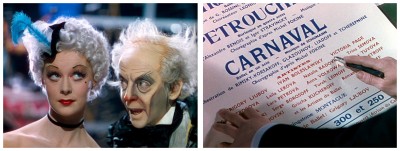 Perhaps the ballet shouldn’t be stylised at all – after all, it was supposedly staged by the purist Lermontov who, if he had a camera, would insist on it being stationary, no camera tricks, no special effects, and no jazzy musical interludes. The high romance of the telling is intensified by the luridly glowing Technicolor of the film, which must been seen as something of a contrast to the grey austerity of post-war Britain. Although clearly meant as a film for all the family, it is in fact a rather heightened symbolic study of the destruction of lives in the cause of art. This morbidity is emphasised by the film’s centrepiece, the ballet of The Red Shoes (which run away with and totally exhaust their wearer) in which Vicky dances, and comments so clearly on the action of the story. Stylishly fantastic in its preoccupation with death as the true result of art, the film is reminiscent of the symbolically doom-laden films of Jean Cocteau.
Perhaps the ballet shouldn’t be stylised at all – after all, it was supposedly staged by the purist Lermontov who, if he had a camera, would insist on it being stationary, no camera tricks, no special effects, and no jazzy musical interludes. The high romance of the telling is intensified by the luridly glowing Technicolor of the film, which must been seen as something of a contrast to the grey austerity of post-war Britain. Although clearly meant as a film for all the family, it is in fact a rather heightened symbolic study of the destruction of lives in the cause of art. This morbidity is emphasised by the film’s centrepiece, the ballet of The Red Shoes (which run away with and totally exhaust their wearer) in which Vicky dances, and comments so clearly on the action of the story. Stylishly fantastic in its preoccupation with death as the true result of art, the film is reminiscent of the symbolically doom-laden films of Jean Cocteau.
 Despite its marvelous excesses, The Red Shoes is not a perfect film. Because of the cinematic liberties taken and excesses of the ballet sequences, it’s difficult for the viewer to readjust to the realistic scenes that follow. The first half of the film is masterful, the second half becomes rather miserable. The male directors (who manipulated us into disliking Lermontov so much that we have trouble realising that what he wants for Vicky is what’s best for her) finally punish Vicky for making the wrong, seemingly selfish decision to choose dance over Craster. They even have her recognise her mistake by insisting that her red shoes be removed from her feet.
Despite its marvelous excesses, The Red Shoes is not a perfect film. Because of the cinematic liberties taken and excesses of the ballet sequences, it’s difficult for the viewer to readjust to the realistic scenes that follow. The first half of the film is masterful, the second half becomes rather miserable. The male directors (who manipulated us into disliking Lermontov so much that we have trouble realising that what he wants for Vicky is what’s best for her) finally punish Vicky for making the wrong, seemingly selfish decision to choose dance over Craster. They even have her recognise her mistake by insisting that her red shoes be removed from her feet.
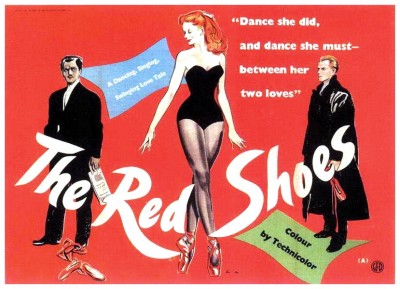 Michael Powell was to make good use of all this cinematic experience with love, sex, death and spectacle, when he made the remarkable Peeping Tom (1960), a non-fantasy horror film about a shy, impotent, homicidal voyeur who specialises in filming the frenzies of fear in his female victims just before he kills them – a rather cynical comment on the entire horror film genre – but that’s another story for another time. Right now I’ll take this opportunity to invite you to join me again next week when I throw you another bone of contention and harrow you to the marrow with another blood-curdling excursion through the darkest dank streets of Hollywoodland for…Horror News! Toodles!
Michael Powell was to make good use of all this cinematic experience with love, sex, death and spectacle, when he made the remarkable Peeping Tom (1960), a non-fantasy horror film about a shy, impotent, homicidal voyeur who specialises in filming the frenzies of fear in his female victims just before he kills them – a rather cynical comment on the entire horror film genre – but that’s another story for another time. Right now I’ll take this opportunity to invite you to join me again next week when I throw you another bone of contention and harrow you to the marrow with another blood-curdling excursion through the darkest dank streets of Hollywoodland for…Horror News! Toodles!
The Red Shoes (1948)
 Horror News | HNN Official Site | Horror Movies,Trailers, Reviews
Horror News | HNN Official Site | Horror Movies,Trailers, Reviews
